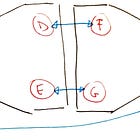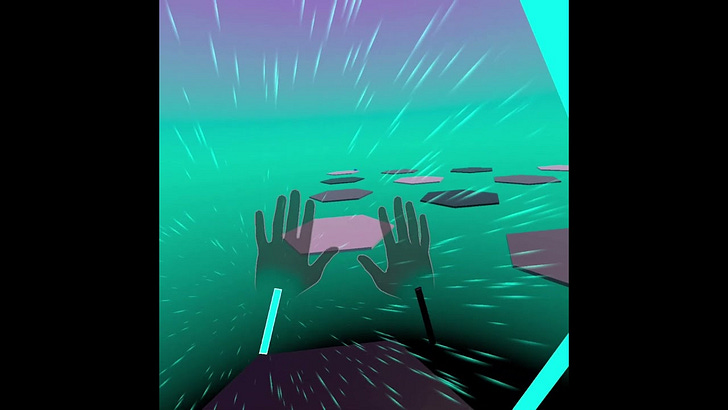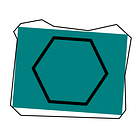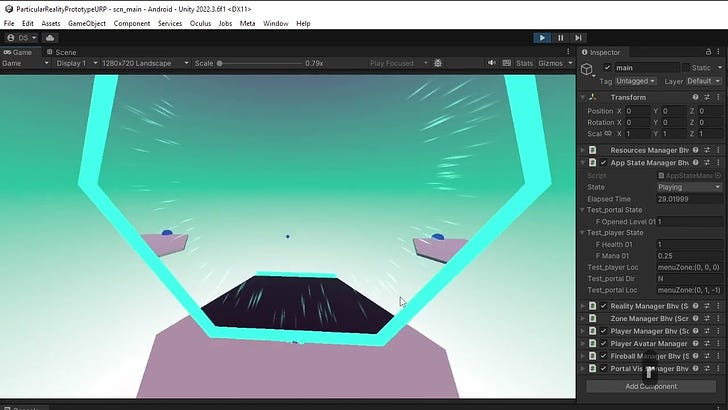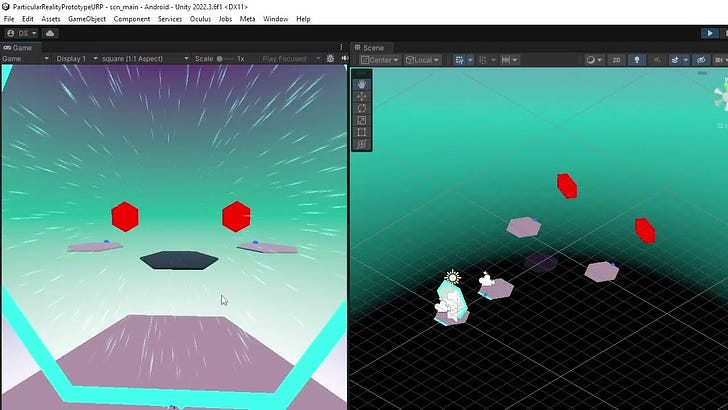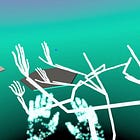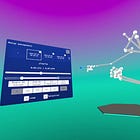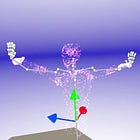Happy birthday, Particular Reality
While I announced Particular Reality at the end of September 2023, I started prototyping it a bit earlier, on August the 5th. This means that this week marked the first birthday of the project!
I think it's the perfect moment to summarize what I've been doing, try to draw a balance of the work so far, and write a few words about how I plan to proceed.
How much time did I work on the project?
As shown by the yearly "heat-map" above, in the past year I managed to do:
16 full-immersion days of "Proof Of Concept prototyping"
roughly 10 hours/day
23 weeks of part-time "Advanced Prototyping"
roughly 20 hours/week (4 hours/day, 5 days/week)
That's strictly development time working on the game and writing the DevLog entries related to that work, so not considering auxiliary tasks like:
working on the game website and social media accounts
writing "extra" articles (like this one you're reading now)
preparing material exclusively useful for social media
dealing with hardware/software problems preventing me to work
The "extra" articles required a very variable amount of effort. Some were written in a couple of hours, while others required a lot of work. In some case, the write-up itself was pretty fast, but was about a very time intensive task.
All things considered, not too bad but not great either.
Unfortunately, when other work or family related priorities arise, Particular Reality gets paused.
It's the price to pay for low-stress creative freedom, as discussed in a previous article.
Did I fulfil my own expectations?
If you're a developer, you're probably familiar with the awesome Hofstadter's Law:
It always takes longer than you expect, even when you take into account Hofstadter's Law.
Of course, this also applied to the development of Particular Reality.
I was quite happy of the results I got in only 16 days of full immersion, the phase I labelled "Proof of Concept Prototyping". For the next phase, the "Advanced Prototyping", the idea was reaching roughly the same features of the PoC, but properly engineering them, so that they can be extended and be the backbone of the full game.
If at the end of the PoC developement you would have asked me an estimate for this "Advanced Prototyping" phase, I would have probably guessed "about 3 months".
Instead, 23 weeks of development later, I'm not done yet.
And honestly, it's fine. I won't rush it. Successful estimates in software development are mostly a fairy tale anyway.
What did I get done, and what not?
I did some significant work on the game world management, going from a static, hardcoded demo map to an extensible, dynamic level management built around the idea of interconnected "zones" which can be designed indipendently.
The portal management itself was significantly improved from the version of the PoC, and I introduced the "bridge portals", which allow going from one zone to another.
Then, I introduced a player avatar, using upper body tracking (in the PoC I used "default", basic hand tracking), and did a lot of work related to the capture and playback of body motion, that I'm going to use for displaying "tutorial" gestures and for enemy animations.
I started working on a modular, extensible architecture that should allow me to load, save, pause and rewind the game.
Recently, I finally put back some enemies, implementing a wave management system and some other details that will allow me to have different kinds of enemies with different characteristics.
What's still missing, then, which was available in the PoC?
it was possible to to shoot fireballs
there was player health/mana management, and related pickups
it was briefly possible (before I scrapped the feature from the PoC, to keep the scope limited) to pick up and use a melee weapon
I will proceed to add back in these features in the upcoming development weeks, each time trying to implement them in an extensible, robust way. For example, I don't just want to shoot fireballs, I want a subsystem that can activate different gameplay actions depending on the player equipment and gestures. Fireballs will just be one of many usages of such subsystem.
Did anybody care about all this?
So far, the project has not received significant attention.
The DevLog has only a few subscribers, and social media following is scarce too.
Still, there's a small set of loyal readers which make me happy, and some friends who support me with likes or reposting them to their audience. That's super-appreciated.
I hoped in a little more recognition, but I don't care that much. I know very well that there's an abundance of good projects out there, often better presented, and that the attention span of people online (myself included) is very short these days.
The core hook of the game should be its locomotion system, and that's something that is difficult to show in a convincing way to a mainstream audience. A handful of VR gamers and developers interacted with me enthusiastically about the concept, and that was refreshing.
I know very well that games catch people's eyes with cool visuals, before everything else, and the Particular Reality prototype graphics is currently awful: a bunch of placeholder elements and test colors picked almost randomly, with a couple of particle VFXs thrown in, a feeble attempt to push the imagination towards the right direction.
But I don't want to focus on the visuals right now: I want to complete the core gameplay systems first. I'm trying to play the long game, and I'm accepting that most people won't care at all about the project at its current stage.
It's also about not picking too many battles at the same time. I'm working hard to keep the gameplay logic separated from the presentation, so that I will be able, when the time comes, to focus on the visuals without breaking the gameplay (too much).
That said, I plan to change the most awful elements (like the red/green bridge portal *covers*) soon, provided it's something that doesn't take too much time. When I get to have all the PoC features implemented in the current version of the game, I'll capture new videos for the website and try to push them a little on social media.
Long story short: I'm not satisfied, but I'm not disappointed either. I will be disappointed only if the game will fail to gain any attention even when it will feature "real" graphics and audio.
Which might very well happen, but hey, let's hope not.
Meanwhile, if you want to push the project towards some kind of "social media respectability", you can follow its account on your favourite platform (or, even better, on all of them!).
And of course, if you're interested in articles like this one, consider subscribing to the DevLog.
Thanks for your support!
Year One Articles
To complete this year-long recap, I'm going to provide an "index" of the DevLog material I published so far, separating the "extras".
If this is the first time you run into an article of the DevLog, well, there's quite a lot of stuff you might want to read!


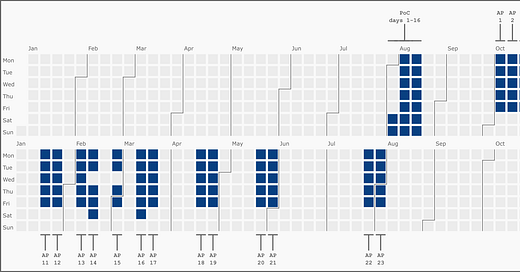








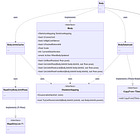
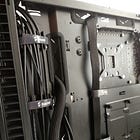

![PoC Prototype - day 01 [2023-08-05]](https://substackcdn.com/image/fetch/w_140,h_140,c_fill,f_auto,q_auto:good,fl_progressive:steep,g_auto/https%3A%2F%2Fsubstack-post-media.s3.amazonaws.com%2Fpublic%2Fimages%2F2ac3ba4a-4edd-4df9-8163-767a95b78156_692x568.png)
![PoC Prototype - day 02 [2023-08-06]](https://substackcdn.com/image/youtube/w_728,c_limit/_0wyMDIQOHU)
![PoC Prototype - day 03 [2023-08-07]](https://substackcdn.com/image/fetch/w_140,h_140,c_fill,f_auto,q_auto:good,fl_progressive:steep,g_auto/https%3A%2F%2Fsubstack-post-media.s3.amazonaws.com%2Fpublic%2Fimages%2Ffacb2c66-56cf-48d6-8a28-4c42bde4788e_1024x1024.jpeg)
![PoC Prototype - day 04 [2023-08-08]](https://substackcdn.com/image/youtube/w_728,c_limit/6jRloHam0mk)
![PoC Prototype - day 05 [2023-08-09]](https://substackcdn.com/image/youtube/w_728,c_limit/7imR7-hrDUE)
![PoC Prototype - day 06 [2023-08-10]](https://substackcdn.com/image/youtube/w_728,c_limit/R1aooiQtMz8)
![PoC Prototype - day 07 [2023-08-11]](https://substackcdn.com/image/youtube/w_728,c_limit/l-3jJ0kM0yk)
![PoC Prototype - day 08 [2023-08-12]](https://substackcdn.com/image/youtube/w_728,c_limit/_XDvxWJea_I)
![PoC Prototype - day 09 [2023-08-13]](https://substackcdn.com/image/youtube/w_728,c_limit/n2OtFww6LrA)
![PoC Prototype - day 10 [2023-08-14]](https://substackcdn.com/image/youtube/w_728,c_limit/XGzrZi4Gejg)
![PoC Prototype - day 11 [2023-08-15]](https://substackcdn.com/image/youtube/w_728,c_limit/J3vgvLGwdX4)
![PoC Prototype - day 12 [2023-08-16]](https://substackcdn.com/image/youtube/w_728,c_limit/sOkLYQrHCGI)
![PoC Prototype - day 13 [2023-08-17]](https://substackcdn.com/image/fetch/w_140,h_140,c_fill,f_auto,q_auto:good,fl_progressive:steep,g_auto/https%3A%2F%2Fsubstack-post-media.s3.amazonaws.com%2Fpublic%2Fimages%2F74d72f65-a691-4a89-80cf-ab50eaaac387_483x485.png)
![PoC Prototype - day 14 [2023-08-18]](https://substackcdn.com/image/fetch/w_140,h_140,c_fill,f_auto,q_auto:good,fl_progressive:steep,g_auto/https%3A%2F%2Fsubstack-post-media.s3.amazonaws.com%2Fpublic%2Fimages%2F9ce0c80c-ec5d-4b6a-b91a-0449648e8da2_4000x2250.jpeg)
![PoC Prototype - day 15 [2023-08-19]](https://substackcdn.com/image/youtube/w_728,c_limit/pIKz3IJ7tXg)
![PoC Prototype - day 16 [2023-08-20]](https://substackcdn.com/image/youtube/w_728,c_limit/_jGtGUSaKX8)


